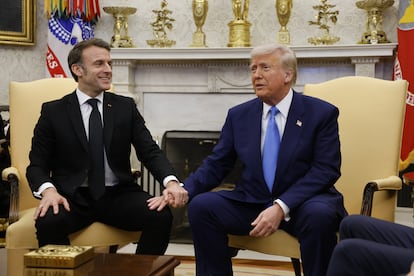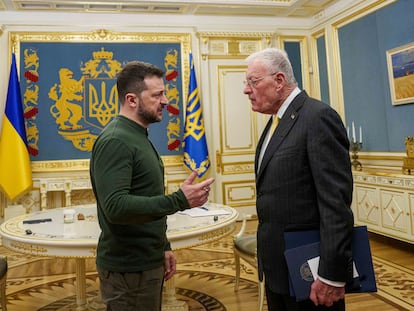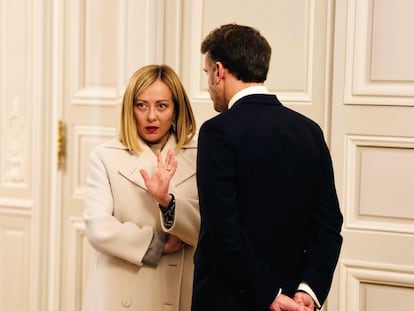Trump and Macron display wide differences over Ukraine war in White House meeting
The French president’s visit to Washington is part of European efforts to prevent an agreement that would be detrimental to Kyiv


An end to the war with Russia “must not mean a surrender of Ukraine, it must not mean a ceasefire without guarantees,” French President Emmanuel Macron told his U.S. counterpart Donald Trump at a joint press conference. “This peace must allow for Ukrainian sovereignty and allow Ukraine to negotiate with other stakeholders regarding the issues that affects it,” he added. The two leaders met in the Oval Office on Monday to discuss the future of Ukraine, on the third anniversary of the war, in a visit that is part of European efforts to persuade Trump not to reach an agreement in his negotiations with Russia that excludes Kyiv, or that hands the advantage to Moscow and is unacceptable for the invaded country.
The two leaders expressed optimism after a meeting they described as very important for the future of Ukraine. But behind the smiles, the long handshakes, and the lavish praise from Macron, it was clear that differences persist between the White House and its European allies, particularly on security guarantees that would prevent the Kremlin from repeating its military aggression in the future. Macron repeatedly pointed to the Minsk agreements of 2014 and 2015 — signed after Russia annexed the Ukrainian peninsula of Crimea — which did not prevent the invasion in 2022. Trump avoided commenting.
Following Monday’s meeting, some possible steps for Ukraine’s future are beginning to take shape: the U.S. and Ukraine could finalize their agreement in the next few days for Kyiv to cede revenues from the exploitation of its minerals and rare earths; Ukrainian President Volodymyr Zelenskiy would travel to Washington to sign the pact this week or next, according to Trump; in the negotiations, a ceasefire would be agreed upon first, then a peace agreement would be addressed with the details of reconstruction; once the cessation of hostilities is agreed upon, Europe would form a force of tens of thousands of soldiers to monitor its compliance.
“Europe is willing to step up to be a stronger partner, to do more in defense and security for its continent,” said the French president at the meeting of the two leaders, the first between Trump and a European representative since his inauguration last month. This contribution would involve sending troops, although not to act as a peacekeeping force but to “mark a presence” and act as a guarantee of security for Ukraine against possible Russian attacks in the future.
For his part, Trump indicated that Russia would have no objections to such a deployment of European troops — something that, if so, represents a change in the Kremlin’s position, which until now has been radically opposed to a European military presence. In a press conference after the meeting, Trump said, with satisfaction, that “President Macron agrees that the cost and burden of securing the peace must be borne by the nations of Europe, not alone by the United States.”
Although several European countries, such as the United Kingdom, have expressed their willingness to contribute troops to such a force, the bloc admits that it would not be a sufficient deterrent on its own and has called on the United States to guarantee its support in the event of a new Russian attack. “We do share the objective of peace but we are very aware of the necessity to have guarantees and a solid peace in order to stabilize the situation,” Macron stressed. The French president said that alongside the European force “the Americans will be there in solidarity,” but he did not specify whether they would be a symbolic presence, provide intelligence data, or form a support contingent to intervene in case of danger.
The French president also responded to Trump’s statements on two occasions to correct him: Russia, he recalled, is “the aggressor” in the conflict. And Europe has provided “60%” of aid to Ukraine, despite the White House insisting that Washington has been the main contributor.
More significantly, given the differences between Washington and its allies, as the two leaders met in the White House the United States sided with Russia for the first time at UN headquarters in New York in a vote on a resolution on the war in Ukraine, in a new sign of heightened European concern about which side the United States is really on.
Trump insists on rare earths deal
In the Oval Office, Trump again stressed the importance he attaches to the pact with Ukraine to receive a share of that country’s revenues from the exploitation of its abundant mineral resources and rare earths, as payment for the U.S. military aid it has received during the war. It is an agreement he hopes to close “very soon,” and which his administration defends with the argument that the American investment would link the economies of the two countries and give Washington an incentive to protect Ukraine.
Zelenskiy refused to sign the first version of the deal, which called for $500 billion in compensation for the aid, saying the amount was far too high and did not offer security guarantees for Ukraine. But as negotiations have continued, he has softened his position. On Sunday, he posted on social media that “great progress” was being made in those talks, but insisted that he wants “a good economic agreement that is part of a real system of security guarantees for Ukraine.”
Macron’s visit is part of a series of initiatives by Kyiv’s allies to try to persuade Trump against a deal that would benefit Moscow. The Republican has undertaken a 180-degree turn in his foreign policy to limit ties with the Old Continent, a great ally for 80 years, and to sideline Kyiv while building wide bridges toward Russia, a historical rival of Washington and isolated in the West after the invasion of its neighboring country. The meeting at the White House was followed by a virtual meeting on Ukraine of the G-7. In Kyiv, European leaders commemorated the beginning of the war with a display of solidarity with Zelenskiy. On Thursday, British Prime Minister Keir Starmer will meet with Trump in Washington.
Sign up for our weekly newsletter to get more English-language news coverage from EL PAÍS USA Edition
Tu suscripción se está usando en otro dispositivo
¿Quieres añadir otro usuario a tu suscripción?
Si continúas leyendo en este dispositivo, no se podrá leer en el otro.
FlechaTu suscripción se está usando en otro dispositivo y solo puedes acceder a EL PAÍS desde un dispositivo a la vez.
Si quieres compartir tu cuenta, cambia tu suscripción a la modalidad Premium, así podrás añadir otro usuario. Cada uno accederá con su propia cuenta de email, lo que os permitirá personalizar vuestra experiencia en EL PAÍS.
¿Tienes una suscripción de empresa? Accede aquí para contratar más cuentas.
En el caso de no saber quién está usando tu cuenta, te recomendamos cambiar tu contraseña aquí.
Si decides continuar compartiendo tu cuenta, este mensaje se mostrará en tu dispositivo y en el de la otra persona que está usando tu cuenta de forma indefinida, afectando a tu experiencia de lectura. Puedes consultar aquí los términos y condiciones de la suscripción digital.
More information
Archived In
Últimas noticias
Families demand repatriation of bodies of Colombians who died in Ukraine: ‘This war is a slaughterhouse for foreigners’
James Cameron: ‘For the films I like to make to continue to exist, we have to find a way to make them cheaper’
Helen Levitt, the photographer who captured the theater of the everyday
The guardians of the meteorites of the Argentine Chaco
Most viewed
- Christian Louboutin: ‘Young people don’t want to be like their parents. And if their parents wear sneakers, they’re going to look for something else’
- US sanctions against jailed cartel leader ‘El Marro’ highlight Mexico’s lack of control over its prisons
- Cartels in Mexico take a leap forward with narco-drones: ‘It is criminal groups that are leading the innovation race’
- Liset Menéndez de la Prida, neuroscientist: ‘It’s not normal to constantly seek pleasure; it’s important to be bored, to be calm’
- ‘El Limones’ and the growing union disguise of Mexican organized crime










































